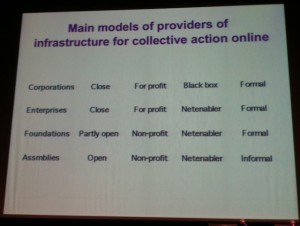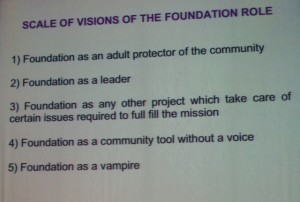
Mayo Fuster Morell’s website
I will present results of my research concerning governance on digital commons, which was a research based on a comparative analysis of case studies, one of which was Wikipedia. It is noteworthy that most research focused on governance on online communities focus on the interaction between participants of the community, which is an important issue. But my focus on this research is on the providers of the infrastructures of these communities and the relationship between the community and these providers. In the case of Wikipedia, the provider is the Wikimedia foundation.
The goal of this research is to gain insight on whether different kind of providers effect the community that emerge. I analyzed the relationship between the type of provider and merging communities -In types of scale – Types of collaboration and -Level of self-governance within the community.
First, I would like to demonstrate my analysis of infrastructure providers and then provide the example of Wikipedia and the Wikimedia foundation.
I identified four elements that define the characteristics of an infrastructure provider;
I) Openness vs. Closeness with respect to community participation
II) Sustainability; Whether the provider is for-profit or non-profit
III) Level of freedom and autonomy the community is given. ‘netenabler’ vs. ‘blackbox’ infrastructures; Whther the platform is based on open-source software of proprietary protocols and data management. This determines the fork-ability and data mobility.
IV) Formal vs. Informal of the organization.
I analyzed 50 cases according to these parameters and identified 4 main categories (Illustrated by slide below)

Case Study of Wikipedia – Role of Wikimedia foutdation
CPOV blog has previously published Maya Fuster Morell’s analysis of the evolution of the Wikimedia foundation, which can be accessed here.
The involvement of the foundation seem to have evolved on a case-by-case basis and the power relation between the community and the foundation seems to be in flux and is actively discussed in the community. The opinion of the community regarding the involvement of the foundation into the activities of Wikipedia can be placed on a scale [See slide 2]

Based on this analysis, the Wikimedia foundation represents a very formal structure with a high degree of professionalization.These characteristics are against many features of the Wikipedia community. Why? Also, how do these radically different modes of organizations co-exist?
It is noteworthy that both the foundation and the community have adopted different governance styles and power structures depending the need and task at hand and have moved from one to another fluidly, even applied two concurrently to different parts. While consensus is central, sometimes the founder exercises his monarchical power for example.
It appears that the foundation has adopted this formal and professional outlook in order to provide technical infrastructure to the community but also to handle legal support and public relations on a professional level. The community, on the other hand, creates the content and the rules and regulations that relate to the creation of content. Ownership is also representative, the Wikipedia logo and other PR material are owned by the foundation while the community can claim ownership of the content they create.
This creates a mutual dependency between the foundation and the community. This does not necessarily mean the power and rights of ownership of the foundation and the community are symmetrical, but it means their contrasting systems co-exist and work for the benefit of the project together. This also creates a very interesting dialogue between the foundation and the community where there is a continuous negotiation of power between them, rendering the power distribution fluid. In understanding this relationship, the concepts of lateral source of authorship and parallel governing.
The hybrid model of Wikipedia can be a model for other institutions of rethinking global institutions of the public and political in the 21st cent. We have to remember that the issue is not how to criticize Wikipedia. They constitute a new form of providing public goods, we have to think about our responsibility to Wikipedia, to improve and learn from it, since it is so important in our lives.
More information about her:


